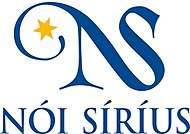Nói Síríus
Nói Síríus (Icelandic pronunciation: [Nói siríus]) is a family-owned chocolate and confection manufacturer in Iceland that was founded in 1920. Hallgrímur Benediktsson took over as main owner in the 1920s, and his grandson, Finnur Geirsson, is the company's current president. Nói Síríus is Iceland's biggest candy producer and its candies have been a traditional part of camping trips since 1933, along with stockfish.[1]
 | |
| Privately held company | |
| Industry | Confectionery production |
| Founded | 1920 |
| Founders | Eiríkur Bech, Gísli Guðmundsson, Loftur Guðmundsson, Þorgils Ingvarsson and Hallur Þorleifsson |
| Headquarters | , |
Key people |
|
| Products | Chocolates |
Number of employees | 130 |
| Website | noi.is |
The company produces Tópas and Opal, "fresh breath products" known for being somewhat bitter and soothing a sore throat with menthol and eucalyptus,[1][2] as well as pastilles, sugar twists, assorted chocolates (a Christmas tradition) and Easter eggs. The chocolates come in dark and milk chocolate varieties as well as bars with nuts and raisins, whole hazelnuts, raisins and liquorice chips. The company also produces a "Little Imps" lines for children that includes "candy covered chocolate drops, hot and spicy pepper drops, fruity jellies with a candy shell or colourful little gum drops".
Nói Síríus candies are sold domestically in Iceland and exported, primarily to Russia and the United States.[3] Smaller quantities are shipped to Denmark and the Netherlands under the Oxydent and Fakta brands.[1]
International expansion
In the late 1990s the company purchased a stake in Laima, Latvia's largest candy manufacturer, but sold it in 2004.[4][5] In March 2006 the company bought English chocolate company, Elizabeth Shaw, but sold it in May 2009 and focused on its own brands.[5]
In August 2019, Orkla acquired a 20% minority stake in Nói Siríus.[6]
Candy culture
Chocolate is a mainstay of Icelandic culture. Eating a chocolate bar at 9 a.m. is culturally acceptable, intellectuals offer bowls of candy as an appetizer before dinner, and Nói Síríus produces 300,000 chocolate Easter eggs in a nation of 340,000 people.[7] The Easter eggs are made at the company's Reykjavík plant, and a note with a saying is put into each egg.[8] Icelandic liqueurs bearing the Tópas and Opal name have also been introduced, achieving some acclaim, with filmmaker Quentin Tarantino's description of them as "the worst drink on earth" after an evening imbibing them.[1]
The company also made news in 2007 for a controversial marketing campaign and promotion stunt that had people join a Labor Day demonstration with signs labeled with Nói-Síríus-produced Tópas candy while shouting advertising slogans.[9]
References
- "A Sweet Friend of the Icelandic people; Nói Síríus expands beyond domestic shores". Issues and Images Iceland. 2: 13. 2006.
- Moerland, Mariska (August 13, 2018). "Icelandic Candy You Should Try". WhatsOn Iceland. Retrieved December 4, 2019.
- "Icelandic Easter eggs at Whole Foods". Iceland Review. February 23, 2007. Retrieved December 4, 2019.
- Arklina, Ilze (January 18, 2001). "Deals show some investors are not so sweet". The Baltic Times. Retrieved December 4, 2019.
- Gudmundsson, Haraldur (April 16, 2014). "Seldu 434 tonn af sælgæti til átta landa" [434 tons of candy sold to eight countries]. Vísir.is (in Icelandic). Retrieved December 4, 2019.
- White, Martin (August 22, 2019). "Orkla acquires stake in Icelandic chocolate company Nói Siríus". foodbev.com. Retrieved December 4, 2019.
- Eye Candy Summer 2008, Vol. 8, No. 3, Pages 39–42 , DOI 10.1525/gfc.2008.8.3.39 August 7, 2008 Gastronomica
- "Icelanders to Eat One Million Chocolate Easter Eggs". Iceland Review. March 22, 2013. Retrieved December 4, 2019.
- "Nói-Síríus criticized for advertising in demonstration". Iceland Review. May 2, 2007. Retrieved December 4, 2019.